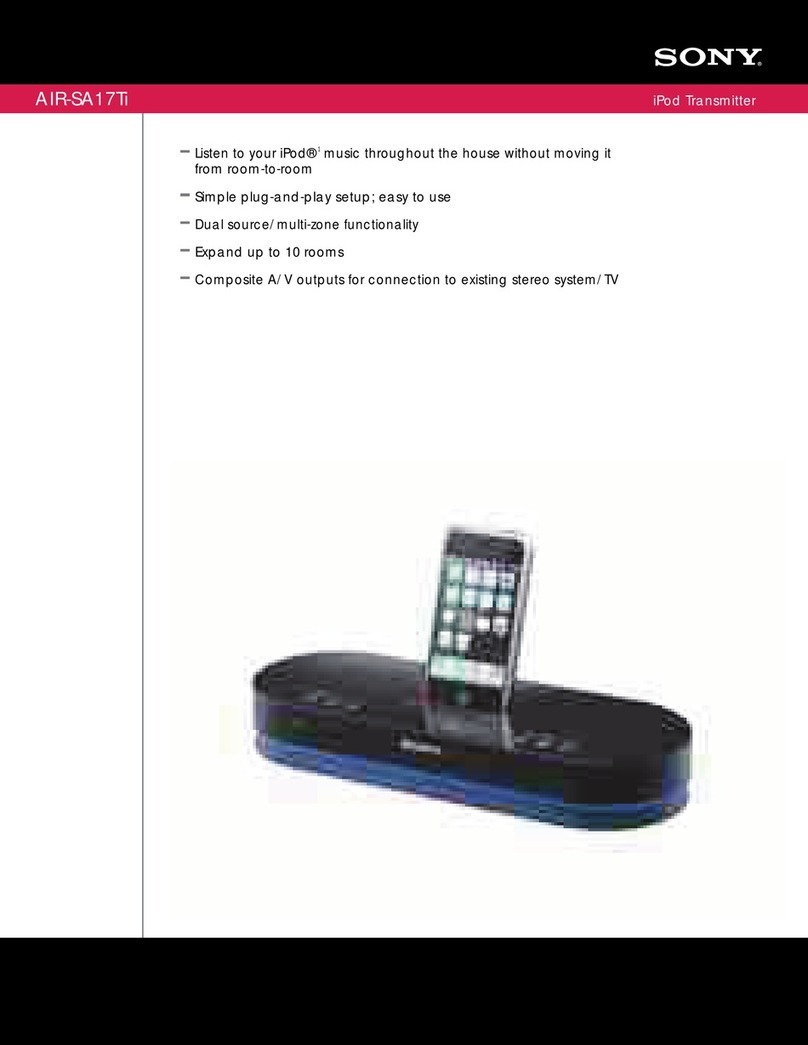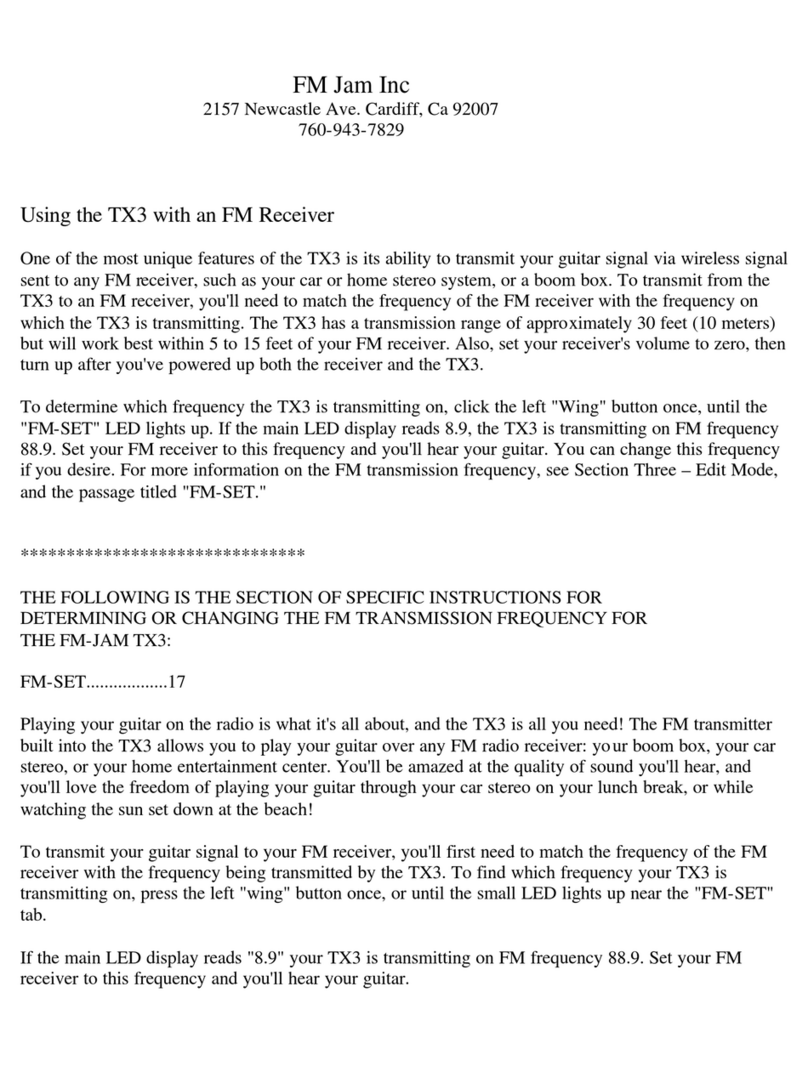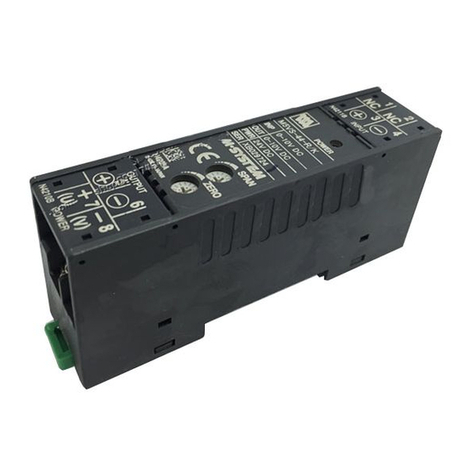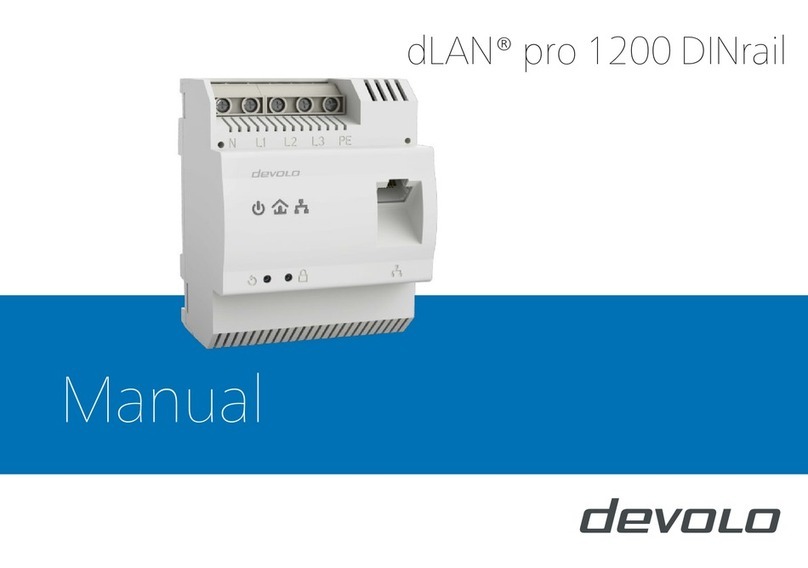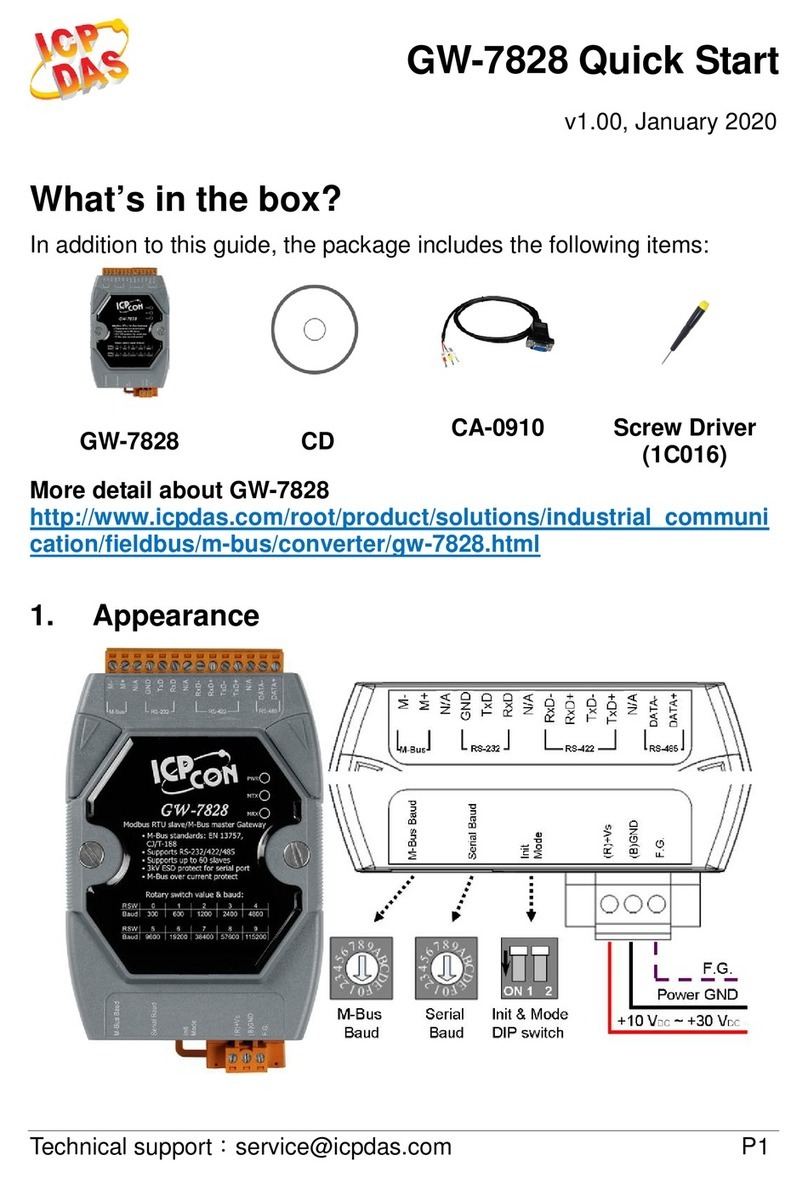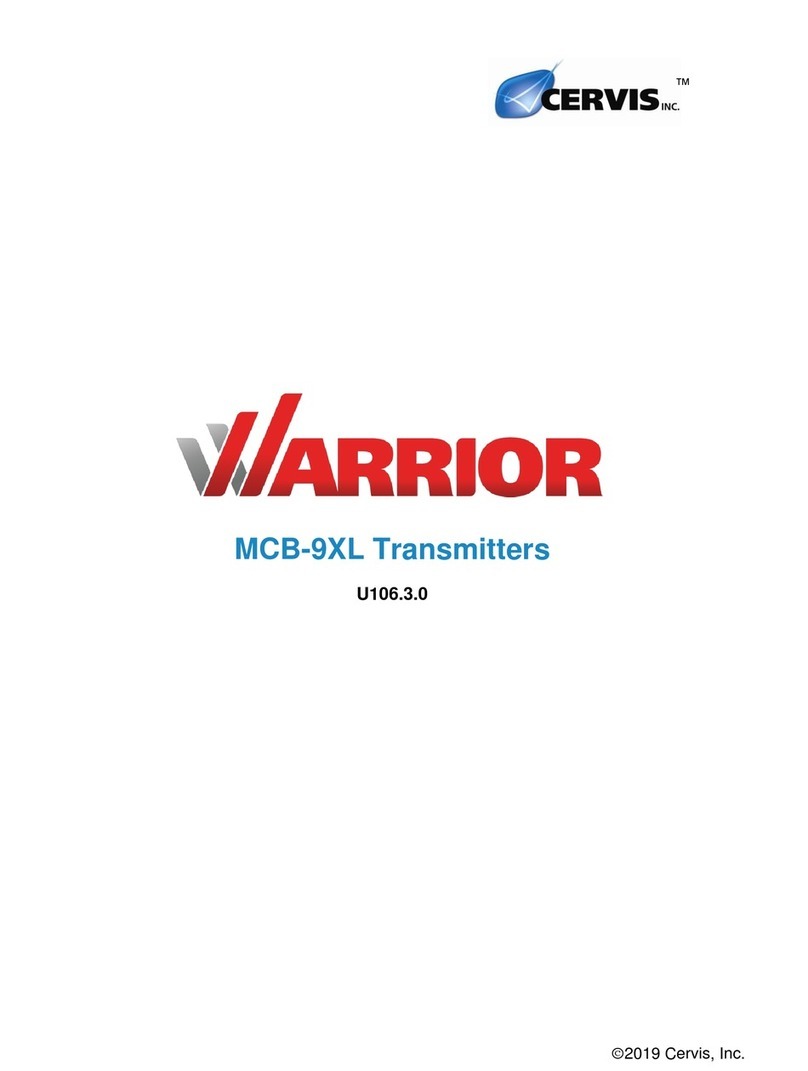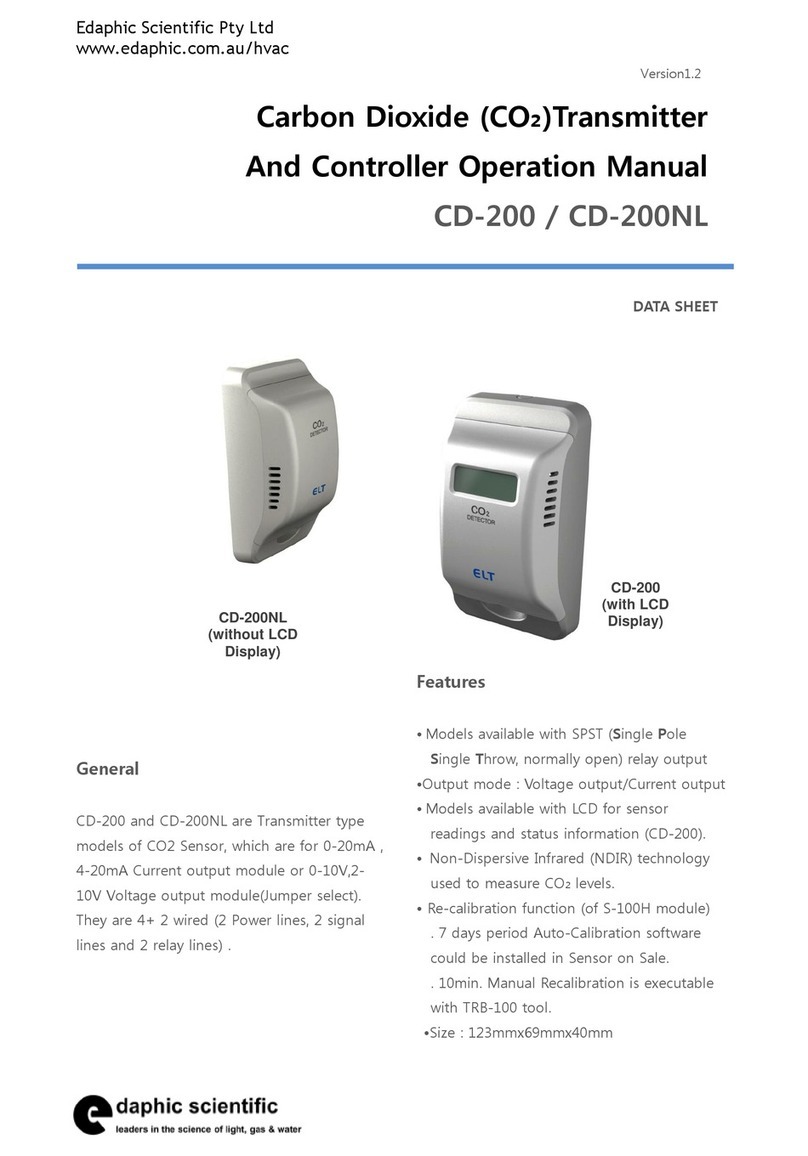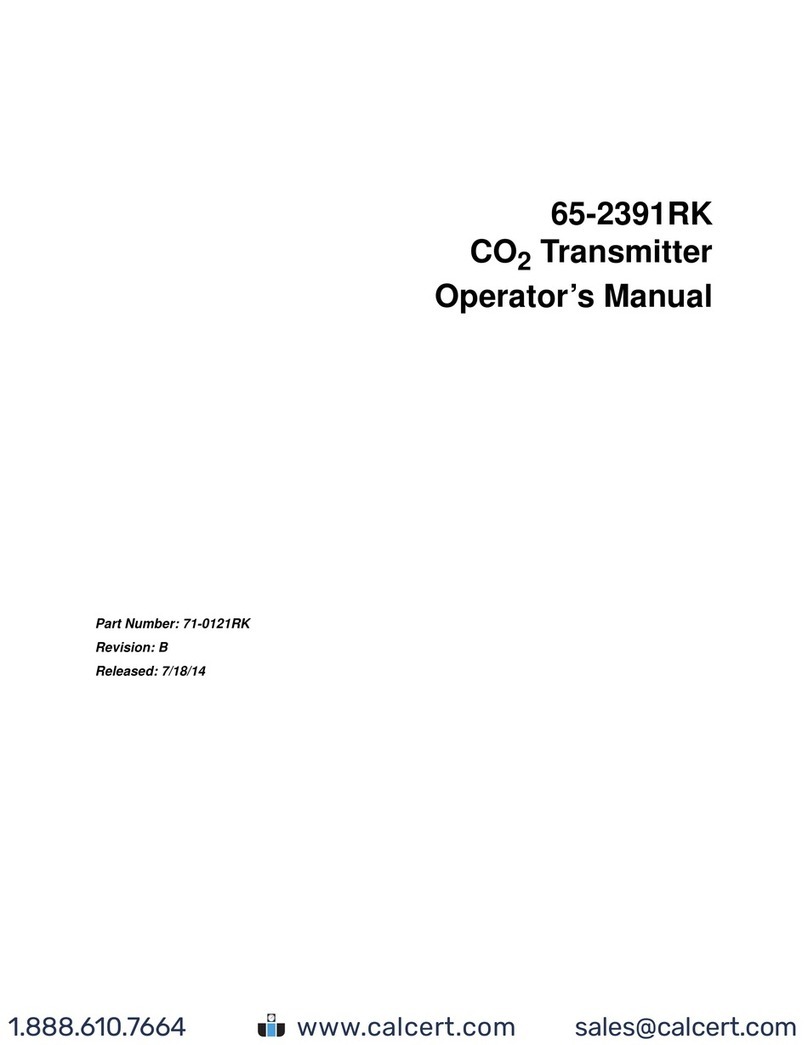Hitech Nivelco Nivocap C-200 Assembly instructions

TÛV-A 03 ATEX 0019X ♦cbr2052a0600p_01 ♦36/1
N IV O C A P
C -2 0 0 , C - 2 0 0 Ex, C - 3 0 0
tw o -w ire com pa ct ca pa cita nce
level t r a n s m it ter
INSTALLATION AND PROGRAMMING MANUAL
1st Edition
HiTECH/NIVELCO Co.
301 Oxford Valley Road, Bldg 505 Yardley, PA 19067-7711
Phone.: (215) 321-6012 ♦Fax: (215) 321-6067
e-mail:sales@nivelco.com ♦www.nivelco.com

2/36 ♦TÜV-A 03 ATEX 0019X ♦cbr2052a0600p_01

TÜV-A 03 ATEX 0019X ♦cbr2052a0600p_01 ♦36/3
C O N T E N T S
1.INTRODUCTION............................................................................5
2.ORDER CODE...............................................................................6
3.TECHNICAL DATA........................................................................7
3.1. ADDITIONAL DATA FOR EX MODELS...........................................8
3.2. CONDITIONS OF EX APPLICATION..............................................8
3.3. SAP-202 DISPLAY MODULE.....................................................8
3.4. DIMENSIONS...........................................................................9
3.5. ACCESSORIES.......................................................................10
3.6. MAINTENANCE AND REPAIR....................................................10
4.INSTALLATION...........................................................................11
4.1. MOUNTING AND WIRING .........................................................11
4.2. CHECKING OF THE LOOP CURRENT .........................................12
5.PROGRAMMING .........................................................................13
5.1. PROGRAMMING WITHOUT DISPLAY MODULE.............................14
5.2. PROGRAMMING WITH THE SAP-202 DISPLAY MODULE.............17
5.2.1 SAP-202 display module..............................................17
5.2.2 Steps of the programming ............................................18
5.2.3 Indications of the SAP-202 Programming Module and
the LEDs.......................................................................19
5.2.4 QUICKSET...................................................................20
5.2.5 Full parameter programming........................................22
6.PARAMETERS –DEFINITIONS AND PROGRAMMING........... 23
6.1. MEASUREMENT CONFIGURATION ........................................... 23
6.2. CURRENT OUTPUT................................................................ 27
6.3. MEASUREMENT OPTIMALISATION ...........................................28
6.4. VOLUME MEASUREMENT ....................................................... 29
6.5. 32-POINT LINEARISATION ...................................................... 29
6.6. SERVICE PARAMETERS (READ ONLY)...................................... 31
6.7. TEST PARAMETERS............................................................... 31
6.8. SIMULATION......................................................................... 32
6.9. ACCESS LOCK ...................................................................... 32
7.ERROR CODES.......................................................................... 33
8.SUMMARY OF THE PARAMETERS.......................................... 35

4/36 ♦TÜV-A 03 ATEX 0019X ♦cbr2052a0600p_01
CAPACITANCE LEVEL MEASUREMENT
!" #$!&% '('% )+*-,$.0/
1235476 898$6
:<;-=&>@?AB CDE
FG H IKJ$L$M L$N7L$O J$PRQJ SLTM G ORLUH G I0UJ G P$OJ UVM L
W XYZ
[\
] ^
^ _`
abc
de
f g
h ij
k l
m no
np
q r
s t
u v
w x y
vz
{
x |
z
}
x ~
y
}
z

TÜV-A 03 ATEX 0019X ♦cbr2052a0600p_01 ♦36/5
Thank you for choosing a NIVELCO instrument
We are sure that you will be satisfied throughout its use
1. INTRODUCTION
NIVOCAP CT-200 is a two-wire capacitance level transmitter for measuring level and volume (weight) of conductive or not-conductive liquids or free flowing
solids.
APPLICATION
The active probe of the unit and the conductive wall of the vessel (or a grounded reference probe if the wall is not conductive) make up the plates of a capacitor.
Insulator of the probe, surrounding air or the material in the tank provide dielectric material.
If the tank is empty the basic capacitance is C0while the dielectric coefficient “εr” of the air is 1. If the air will be replaced by material with higher dielectric
constant than that of the air, the capacitance will be changed, i.e. capacitance will increase with rising material. This change of the sensed capacitance
converted to output signal will be proportional to the level change. The same time the condition of level gauging is direct proportionality between the level
change and the change of the capacitance.
The value of capacitance also depends on the distance between the plates, the condition above will be met if the active probe is parallel to he tank wall or with
the reference probe. Thus reference probe should be used in a tank with unusual shape or cylindric tank in a horizontal position even if the wall is conductive,
provided the medium is not conductive.
Due to the level measurement on the capacitance principle it is essential to measure and store capacitance at two different levels in the tank (teaching), when
the unit is “learning “ surrounding conditions of the actual application (e.g. C0 is different on the workshop bench and on site in the tank etc.).
Improper selection of the probe and very low dielectric constant may prevent the measurement.
For conductive materials (e.g.. water, acid,, bases, solutions with water, etc.) insulated active probes should be used., while value of the dielectric constant is
indifferent. Both insulated and uninsulated probes can be used for non conductive materials but dielectric constant must be over 1.5 (εr> 1.5).
VOLUME AND WEIGHT MEASUREMENT
This measurement is supported by the volumetric calculation feature and arithmetical formula for the most commonly used tank shapes in the software. Thus
measuring level, volume or weight of the medium in the tank can be transmitted and displayed.
LINEARISATION
If there is no direct proportionality between the change of capacitance and change of level the 32-point linearisation feature should be applied. Linearisation is
the method of assigning calibrated volume values to level values measured by the unit.

6/36 ♦TÜV-A 03 ATEX 0019X ♦cbr2052a0600p_01
2. ORDER CODE
NIVOCAP
C
-
-
Not all combinations possible!
INTRUSION LENGTH
FUNCTION
CODE
PROBE
CODE
ENCLOSURE
MATERIAL
CODE
CODE
ROD
CODE
OUTPUT / EX
CODE
Transmitter
T
Rod / insulated 1” BSP
R
Aluminium
2
0
0 m
0 m
0
4 ... 20 mA / standard
2
Transmitter + display
B
Rod / uninsulated 1” BSP
P
Plastic
3
1
1 m
0,1m
1
4 ... 20 mA HART/st.
4
Transmitter, high temp
H
Cable / insulated 1” BSP
K
2
2 m
:
:
4 ... 20 mA / Ex
6
Tx, high temp + display
P
Cable / uninsulated 1” BSP
L
3
3 m
0,9m
9
4 … 20 mA HART / Ex
8
Heavy Cable / insulated 1½” BSP
N
Rod / insulated 1” NPT
A
CABLE
Rod / uninsulated 1” NPT
C
0
0 m
0 m
0
Cable / insulated 1” NPT
E
1
10 m
1 m
1
Cable / uninsulated 1” NPT
G
2
20 m
:
:
Heavy Cable / insulated 1½” NPT
J
9 m
9
Order codes of Ex models
include Ex marking
Ex models are with standard
temperatures available only
ACCESSORIES:
HART MODEM SAT-303
DISPLAY MODULE SAP-202
WEIGHT for cable probe CTK-103-0M-40001
WEIGHT for heavy cable probe CTN-103-0M-40000
REFERENCE (TUBE) PROBE NIVOCAP
C
-
1
-
0
•
VERSION / THREAD
CODE
REF. PROBE
CODE
INSERTION LENGTH
Coaxial tube BSP
A
CODE
ROD / TUBE
CODE
Coaxial tube NPT
D
Tube 1½”
F
0
0 m
0 m
0
Reference rod BSP
F
1
1 m
0.1 m
1
Reference rod NPT
E
Rod 1”
P
2
2 m
:
:
3
3 m
:
:
0.9 m
9

TÜV-A 03 ATEX 0019X ♦cbr2052a0600p_01 ♦36/7
3. TECHNICAL DATA
Rod probe
Light cable probe
Heavy cable probe
Range
0.2 ... 3 m
1 ... 20 m
Process connection
St.St. DIN 1.4571
Material of wetted
parts
Probe
Fully or partially PFA coated St. St.
(DIN 1.4301)
Fully or partially FEP coated St. St. cable
PE coated steel cable
Enclosure material
Aluminium casting, Plastic (PBT), glass fibre reinforced (PBT)
Medium temperature (See: temp. diagram)
standard: -30 °C ... +130 °C, high temperature: –30 °C ... +200 °C
–30 °C ... +80 °C
Pressure (See pressure diagram)
maximum 4 MPa (40 bar) +20 °C
maximum 1.6 MPa (16 bar)
Ambient temperature (See temp. diagram
-25 °C ... + 70 °C
Maximum tensile load
–
7.7 kN
45 kN
Saturation capacitance of the probe
~600 pF/m
~200 pF/m
~600 pF/m
Analogue: 4 ... 20 mA. 2-wire (3.9 … 20.5 mA),
Rmax = Ut–11.4 V / 0.02 A isolated, protection against power supply transient
Test connection for loop current 2 mm-socket, output voltage: 1 mV / 1 mA
SAP-202 display module: 6-digit LCD, engineering units and bargraph
Output
HART feature, load resistance ≥250 ohm
Voltage output for current test
Voltage measurement on serial resistance: 1 mV / 1 mA
Capacitance range
0 pF ... 5 nF
Range of transmitted capacitance
10 pF, or 10% (min. SPAN)
Damping
0, 3, 6, 10, 30, 60, 100, 300 s
Fault indication
Blinking of COM and VALID LED and
transmitting 3.8 or 22 mA fault indication current selected by programming
Power supply / current consumption
12 ... 36 V DC, maximum 22 mA / 48 … 800 mW
Accuracy
± 0.3 % (related to the length of the probe)
Temperature coefficient
± 0.02% / °C
Electric connection
Pg 16 cable gland or M 20 x 1.5 or 2 x ½” NPT thread for cable protection tube.
Cable diameters ∅8 ... ∅15 mm, or. ∅6 ... 12 mm ∅9.5... ∅10 mm
wire cross section: 0.5 … 1.5 mm2shielded cable suggested
Process connection
1" NPT or BSP
1½" NPT or BSP
Ingress protection
Probe: IP 68, Enclosure: IP 67
Electric protection
Protection Class III
Mass
2.3 kg with 0.5 m probe
1.9 kg with 3 m probe
4.5 kg with 3 m probe

8/36 ♦TÜV-A 03 ATEX 0019X ♦cbr2052a0600p_01
TEMPERATURE DIAGRAM
PRESSURE DIAGRAM
0
+70
+130
+45
+70
T
am bient
-25
-30
T
[
[
0
+70
+200
+45
+70
T
am bient
T
[
-25
-30
[
STANDARD PROBE
HIGH TEMPERATURE PROBE
¡ ¢
£ ¤
¥ ¦
¤
¦
¤
§ ¨
© ¨
ª ¨
§ ¨
«
¬® ¯±° ² ¬´³¶µ · ¸ ¹
º »
¼½¾
¼¿¾
¼ À ¾
Á
Â®Ã Ä Å Æ ÂKÇ È É$Ê
Ë Ì
3.1. ADDITIONAL DATA FOR EX MODELS
Ex marking
II 1/2G EEx ia IIB T6
Intrinsical safe data
Ci • 30 nF , Li • 100
µ
H, Ui • 30 V, Ii • 8 0 mA, Pi • 0 , 8 W
Power supply
Uo < 30 V, Io < 80 mA, Po < 0,8 W.
3.2. CONDITIONS OF EX APPLICATION
Temperature table
1. The unit should be powered by an intrinsically safe signal processor with [EEx ia IIB] or [EEx ia IIC] certification.
Temperature class
T6
2. The tank and the level measuring instrument shall be connected to an EP network with copper wiring q ≥4 mm2..
Tambient
70 °C
3. The Teflon coating of the rod and cable probes may be charged electrostatically, therefore:
Tmedium
80 °C
•the unit should only be used for level measurement of conductive medium and its specific resistance must not exceed 104Ωm, even under the most unfavourable
conditions and at the most unfavourable place.
•method and the speed of filling or emptying of the tank should be selected in accordance with the medium properties.
•the electronic circuitry of the probe is grounded. An equipotential network should be formed along the intrinsically safe circuit. Distance between the transmitter and the
intrinsically safe power supply (accommodated in the non -hazardous area) must not exceed 100 m.
3.3. SAP-202 DISPLAY MODULE
Display
6 digit LCD, engineering units and bargraph
Ambient temperature
-25 °C … +70 °C
Enclosure
PBT glass fibre reinforced plastic (DuPont)

TÜV-A 03 ATEX 0019X ♦cbr2052a0600p_01 ♦36/9
3.4. DIMENSIONS
ROD PROBE
LIGHT CABLE PROBE
HEAVY CABLE PROBE
HIGH TEMPERATURE
ROD PROBE
CTοο-2, 3οοοο-οο
CBοο-2, 3οοοο-οο
CTοο-2, 3οοοο-οο
CBοο-2, 3οοοο-οο
CTοο-2, 3οοοο-οο
CBοο-2, 3οοοο-οο
CHοο-2οοοο-οο
CPοο-2οοοο-οο
Í
ÎÏ
ÐÑ
Ø
Ò0Ó
(
Ø
Ô ÕRÖ
L
N
×
ØÙ
L
N
ÚÛ
Ø
Ü
(
Ø
ÝÞ ß à
á
á
â
ãä
Ø
å0æ
L
N
ç
è
ç
éê
Ø
å0ë
(
Ø
åìRí
L
N
îïñðò0ó
ôöõ ÷ùøú û®ü
ýÿþ
!"

10/36 ♦TÜV-A 03 ATEX 0019X ♦cbr2052a0600p_01
DISPLAY MODULE
HART MODEM
REFERENCE (TUBE) PROBE
SAP-202
SAT-303
CοοF-1οοοο-0
#%$
COM
VAL ID
&
'
(
°F sec min hour day
) *,+-+/.) 0213
4,5%67 8 9: ;
<>=
?,@
A B
C D
E
FG
3.5. ACCESSORIES
•Warranty
•User’s Manual
•Declaration of conformity
•2 pcs Pg 16 cable gland
3.6. MAINTENANCE AND REPAIR
The unit do not require regular maintenance.
Repairs during or after the warranty period are effected at the Manufacturers. The equipment sent back for repairs should be cleaned or neutralised (disinfected)
by the User.

TÜV-A 03 ATEX 0019X ♦cbr2052a0600p_01 ♦36/11
4. INSTALLATION
4.1. MOUNTING AND WIRING
The probe has to be installed vertically and for non-conductive materials reference probe should be used.
The NIVOCAP probes are mounted by 1" or 1½" process connections using S = 41 or S = 55 open end wrench, respectively.
It is recommended to fix the bottom end of the cable probes. This can be accomplished by fixing the cable loop or bore hole to the tank bottom or by the use of
weight.
The active probe and the reference probe should be installed parallel and next to each other.
ACTIVE PROBE AND CONDUCTIVE TANK
WALL AS REFERENCE PROBE
ACTIVE PROBE AND REFERENCE (TUBE)
PROBE
ACTIVE PROBE AND REFERENCE (ROD)
PROBE
MEASURING FREE FLOWING SOLID WITH
HEAVY CABLE, CONDUCTIVE TANK WALL
AS REFERENCE PROBE
Tank
Tank
Tank
Tank

12/36 ♦TÜV-A 03 ATEX 0019X ♦cbr2052a0600p_01
TEMPERATURE
Electronics of the unit should be protected with shelter against development of
too high temperature by direct sunshine.
HJIKMLNOQPQR
WIRING
•Power must be switched off before wiring the unit.
•This instrument use electronic components that may be damaged by static
electricity thus apply precautions commonly used e.g. touching a properly
grounded point before removing cover of the enclosure
•After removal of the cover of the housing and taking out the display module
(if any), the screw terminals can be accessed. Suggested cable core cross
section 0.5 ... 1.5 mm2 The unit has first to be grounded by the inner or outer
grounding screw.
•After connecting the cable and unit programmed proper sealing and closing
should be ensured.
SUTTVXWUYUZ Z [\]
^U_/`^%a>b c%dfe%gb cUh
ikj j jl/mknoqprs
tUuUvQwxy/zUtUt{ |~}
I-
I+
M /U %
/%U,
~ %U %
P rog ra m m in g
k eys
key s
QU U
¡~¢¤£U¥§¦
4.2. CHECKING OF THE LOOP CURRENT
After removal of the cover of the housing and taking out the display module (if any), voltage measuring instrument should be connected to the test connector.
Setting range to 200 mV the loop current can be measured with an accuracy of ~ 0.5%.

TÜV-A 03 ATEX 0019X ♦cbr2052a0600p_01 ♦36/13
5. PROGRAMMING
Since NIVOCAP is not measuring level directly, the basic element of the programming is measurement (learning) at two different levels during which the
instrument is learning conditions of the actual application (shape of the tank, medium to be measured, etc.). To reach accuracy given in the table of the
Technical Data these two levels should be possibly near to both end of the (rod or cable) probes (See Operation and Programming of NIVOCAP on page 4)
Learning will be represented (with Programming Without Display Module 5.1 and with QUICKSET) by the adjustment of 4 and 20 mA better to say assignment of
0% and 100% to these two output values respectively. In units without display module level will be proportional to the output current while QUICKSET
programming will make possible display in % only.
If level, level in percentage, volume or volume percentage should be measured (a≠0 in P01) and measured values should be displayed in engineering units of
the length [e.g.. m]and volume [e.g. m3]two data pair of the linearisation table (0% and relevant minimum level in e.g. in m as well as 100% and the relevant
maximum level should be entered.. Naturally linearisation should be in the position of ON. (See P47 and P48 on page 30).
Not only the minimum (0%) and maximum (100%) level of the actual application can be assigned (directly) to the 4 and 20 mA output.
If for some reasons of the technology the tank can not be filled to the maximum or emptied to the minimum level the 4 and the 20 mA can indirectly also be
assigned to the minimum (0 %) and maximum (100 %) with the help of two intermediate levels (say to 15% and to 80%).
Obviously -for the sake of accuracy –it is advised to fill/empty the tank to the maximum/minimum level and perform “direct” assignment as soon as possible.
The unit can also be programmed for inverse operation (4 mA = full and 20 mA = empty).
•Programming without display module (See 5.1)
The transmitter is fully operable without display module. Basic parameters such as assignment of 4 and 20 mA to the minimum and maximum level, fault
indication by the output current and damping can be programmed
•Programming with SAP-202 display module (See 5.2)
−QUICKSET –4 parameters can be programmed (See 5.2.4). Programming of the basic parameters will be aided by images on the display. Measured
values can only be displayed in percentage.
−Full parameter programming (See 5.2.5.). All parameters and programming features of the unit can be accessed such as (measurement configuration,
outputs, measurement optimalisation, 11 pre-programmed tank shapes for volume calculation, 32 point linearisation.
−Measured values can be displayed in engineering units
The unit will measure during programming in accordance with the previous parameters. The new, modified parameters will only be effective after returning to the
Measurement Mode
If the transmitter is left in Programming Mode by mistake, it will automatically return to Measurement Mode after 30 minutes and will operate with the parameters
entered during the last programming completed.
FACTORY DEFAULT
Current output and bargraph is proportional to the (capacitance) level percentage. 4 mA and 0% is assigned to the 0 capacitance percentage (low level). 20 mA
and 100% is assigned to 100% capacitance (high level). Current output of the fault indication is 22 mA. Damping: 10 sec.
Note: the 4 and 20 mA assignment is an absolute necessity of the programming.

14/36 ♦TÜV-A 03 ATEX 0019X ♦cbr2052a0600p_01
5.1. PROGRAMMING WITHOUT DISPLAY MODULE
PROGRAMMING FEATURES
•4mA output current (direct) assignment to the minimum (0%) level
•20 mA output current (direct) assignment to the maximum (100%) level
•4 mA output current (indirect) assignment to the minimum (0%) level by means of an
intermediate level
•20 mA output current (indirect) assignment to the maximum (100%) level by means of an
intermediate level
•Fault indication by the current output: 3.8 mA; or 22 mA
•Damping (3 sec, 10 sec, 60 sec)
•Reset to the Factory Default
Remark: current output can be programmed for inverse operation: 4 mA = 100%(full), 20 mA = 0% (empty)
Procedure of programming: press programming keys in the proper sequence and watch state of the LEDs. See interpretation of the LEDs below
= LED “Off”, = LED Blinking, = LED “On” lit, = LED-ek Blinking alternatively = Do not care
“Direct” assignment of 4 mA to the minimum level, 0% (or maximum level for inverse operation)
Fill the tank to the minimum (maximum) level
PROGRAMMING STEPS
LED STATE AFTER PROGRAMMING STEP
1) Press key and keep it pressed
= NIVOCAP in programming mode
2) Press additionally key and keep it pressed
= Assignment of 4 mA to the level in the tank
3) Release both keys
= Programming completed
“Direct” assignment of 20 mA to the maximum level, 100%, (or minimum level for inverse operation)
Fill the tank to the maximum (minimum) level
PROGRAMMING STEPS
LED STATE AFTER PROGRAMMING STEP
1) Press key and keep it pressed
= NIVOCAP in programming mode
2) Press additionally key and keep it pressed
= Assignment of 20 mA-to the level in the tank
3) Release both keys
= Programming completed

TÜV-A 03 ATEX 0019X ♦cbr2052a0600p_01 ♦36/15
Indirect assignment of the minimum and maximum level to the output current with partially filled tank
For this programming the output current is to be measured on the test points as described in 4.2. Should higher accuracy be needed the current meter should be
inserted in the 4 … 20 mA loop.
Assuming a tank filled up to 15% approximately and the task is to accomplish “indirect” assignment of low level to 4 mA the procedure is the following. Since the
current output at the level of 15% is Iout= (16 mA x 0.15) +4 mA = 6.4 mA the current output should be changed with the keys , , until the value of 6.4
appears on the current meter.
This procedure should be repeated with another, higher level for indirect assignment of 20 mA to the maximum level.
Obviously –for the sake of greater accuracy (it is not even sure whether the assumption of 15% is correct) –the “direct” assignment should be accomplished as
soon as it is possible
“Indirect” assignment of 4 mA to the minimum level with partially filled tank
PROGRAMMING STEPS
LED STATE AFTER PROGRAMMING STEPS
1) Press key and keep it pressed
=NIVOCAP in programming mode
2) Press additionally key
E
and keep it pressed, then release keys
=4 mA in programming mode
3) Set output current with keys , to the required value
Save adjustment with key
E
or with key you can return to the value of 4 mA
=4 mA in programming mode
4) Release the key
= Programming completed
“Indirect” assignment of 20 mA to the maximum level w ith partially filled tank
PROGRAMMING STEPS
LED STATE AFTER PROGRAMMING STEPS
1) Press key and keep it pressed
=NIVOCAP in programming mode
2) Press key and keep it pressed, then release keys
=20 mA in programming mode
3)Set output current with keys , to the required value
=20 mA in programming mode
4) Save adjustment with key
E
or with key you can return to the value of 20 mA
=20 mA in programming mode
5) Release the key
= Programming completed
*
**

16/36 ♦TÜV-A 03 ATEX 0019X ♦cbr2052a0600p_01
Selecting “Fault indication” by the current output
As a result of the programming current output will be 3,8 mA; 22 mA.
PROGRAMMING STEPS
LED STATE AFTER PROGRAMMING STEPS
1) Press key and keep it pressed
=NIVOCAP in programming mode
2) Press additionally key
E
, or
and keep it pressed
= -3.8 mA
-22 mA
3) Release both keys
= Programming completed
Adjustment of DAMPING
PROGRAMMING STEPS
LED STATE AFTER PROGRAMMING STEPS
1) Press key
E
and keep it pressed
=NIVOCAP in programming mode
2) Press additionally key , or
,or
and keep it pressed
–3 sec
=–10 sec
–60 sec
3) Release both keys
= Programming completed
Return to DEFAULT
PROGRAMMING STEPS
LED STATE AFTER PROGRAMMING STEPS
1) Press key and keep it pressed
=NIVOCAP in programming mode
2) Press key
E
and keep it pressed
=loading DEFAULT
Indication of programming error with the LED
PROGRAMMING STEPS
LED STATE AFTER PROGRAMMING STEPS = FAULT INDICATED
CORRECTION
Any programming attempt
=blinking twice = no stable surface
Wait for stable surface
Any programming attempt
=blinking three times = no access possible
With SAP-202-only see 5.2 (P99)
Any programming attempt
=blinking four times = NIVOCAP not in default
With SAP-202-only see 5.2 (P01)

TÜV-A 03 ATEX 0019X ♦cbr2052a0600p_01 ♦36/17
5.2. PROGRAMMING WITH THE SAP-202 DISPLAY MODULE
The NIVOCAP should be adjusted to the process by programming the parameters. The SAP-200 Display Module can be used to display the parameters while
programming and measurement values during measurement.
The SAP-200 supports two separately accessible programming modes as below.
QUICKSET (See 5.2.4)
This feature is for quick programming of the 4 basic parameters like with programming without display module but aided by images on the display. Measured
values can only be displayed in percentage.
•Assignment of min level to 4 mA
•Assignment of max level to 20 mA
•Damping
•Fault indication by the current output
Full parameter programming (See 5.2.5)
Highest level programming with availability of all parameters and features such as:
•Measurement configuration
•Adjustment of outputs
•Measurement optimalisation
•11 pre-programmed tank shapes for volume calculation
•21 pre-programmed formula for flow metering
5.2.1 SAP-202 DISPLAY MODULE
Symbols used on the LCD::
•LEV –Level measurement mode
•VOL –Volume measurement mode
•PROG -Programming mode
•FAIL -Measurement / device error
•-Level changing direction
•Bargraph assigned to the level or volume
¨
°F sec min hour day
Symbols used on the frame::
•M–Metric (European) system
•US –US (Anglo-Saxon) system
LED is lit
•COM –digital (HART) communication
ECHO –value within the valid range

18/36 ♦TÜV-A 03 ATEX 0019X ♦cbr2052a0600p_01
5.2.2 STEPS OF THE PROGRAMMING
Programming will be performed by pressing and releasing the relevant one or two keys (simultaneously). Find a short overview of the programming while
detailed descriptions are under 5.2.4 and 5.2.5.
Single key pressing
E
:Selection of address and step to the value of the parameter
Selection of the parameter value and step back to the address
:To move the blinking of the digit to the left
: Increasing value of the blinking digit
:Decreasing value of the blinking digit
©©«ª ¬§¬¬¬
yy Parameter address (P01,
P02…P99)
xxxx Parameter value (dcba)
bargraph
Double key pressing
Press the two keys simultaneously for desired programming step
Entering/quitting programming mode
Basic steps while parameter address is blinking
Basic steps while parameter value is blinking
M®¯ °± ²¯ ³µ´¶M·%¸¹Xº »
Quickset
Full p ar am eter
Access
Retu rn to DEFAULT *
* LOAD readout ** CANCEL readout
Cancelallmodifications**
¼ ½¾¿
À
Á ÂÃ
* cancellation immediatelly active
Return to DEFAULT
Notes:
If the parameter value is not accessible i.e. the parameter address keeps blinking after pressing ENTER
E
,
•the parameter is either a read-out type, or
•the secret code prevents the modification (see P99).
If the modification of the parameter value is not accepted i.e. the parameter value keeps blinking after pressing ENTER
E
,
•the modified value is either out of the range, or
•the code entered is not valid for this parameter

TÜV-A 03 ATEX 0019X ♦cbr2052a0600p_01 ♦36/19
5.2.3 INDICATIONS OF THE SAP-202 PROGRAMMING MODULE AND THE LEDS
Ä
°F sec min hour day
The following process values can be displayed
•Volume– if programmed so
•Level –if programmed so
•Warning indications –FAIL blinking
If the FAIL LED is ON the code of the error can be displayed
and the output current will be in accordance with the Fault
indication
If the FAIL LED is blinking the code of the error can be
displayed and the output current will be in accordance with
the measured value.
SAP-202 indications
Depending on the measurement one of the
below symbols will lit and the process
value displayed (see P01 chapter 6.1).
Engineering units will be indicated directly
or by the lit arrow showing towards them
on the frame
•% percentage
•LEV level
•VOL volume
•FAIL (blinking) Error code displayed
Å,ÆÈÇkÉ
Actual current output value can be displayed
by pressing DOWN .
LED indication
•ECHO-LED
lit in case of
valid echo.
•COM-LED
see description of HART
Ê ËkÌQÍQΧÏÍ ÌÐÒÑ
Ó,ÔJÕ Ö× ØÙMÚ§ÛMÜ
ÝqÞÞ
ß àá«âQàQããä åæ çèá çQéêQàëì ã
í~îXï
ð,ñ á á à«á ò

20/36 ♦TÜV-A 03 ATEX 0019X ♦cbr2052a0600p_01
5.2.4 QUICKSET
Suggested for simple applications
Quick programming of the 4 basic parameters (like with programming without display module but) aided by images on the display. Measured values can only
be displayed in percentage.
QUICKSET can only be used in (%)(DEFAULT) mode (See P01 in Full Parameter Programming 5.2.5).
Keys
Function
E
+ (min. 3 s)
Enter/Quit QUICKSET programming mode
+
LEARNING function
, ,
Adjustment of digit value (increase, decrease) moving blinking
E
Saving displayed value and step to the next screen
+
Reload value before modification (CANCEL)
E
+ (min 3 s)
Return to DEFAULT
+
Display DEFAULT
Screens
Actions
óô õõõ§õ
Assignment of 4 mA to the minimum level , %
Fill the tank to the level required. After entering the Quickset programming mode the learning function can be started
with the double key pressing + . During learning the image „Store” then 0% is displayed.
The parameter value represents filling in %.
“Indirect” assigment of 4 mA to the minimum level with partially filled tank:
Following learning enter the momentary % value of level with the buttons.
The output current will be set in accordance % value.
This manual suits for next models
2
Table of contents
Popular Transmitter manuals by other brands
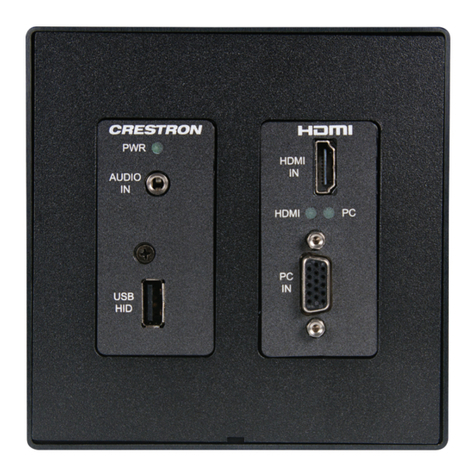
Crestron
Crestron DM-TX-200 Operations & installation guide
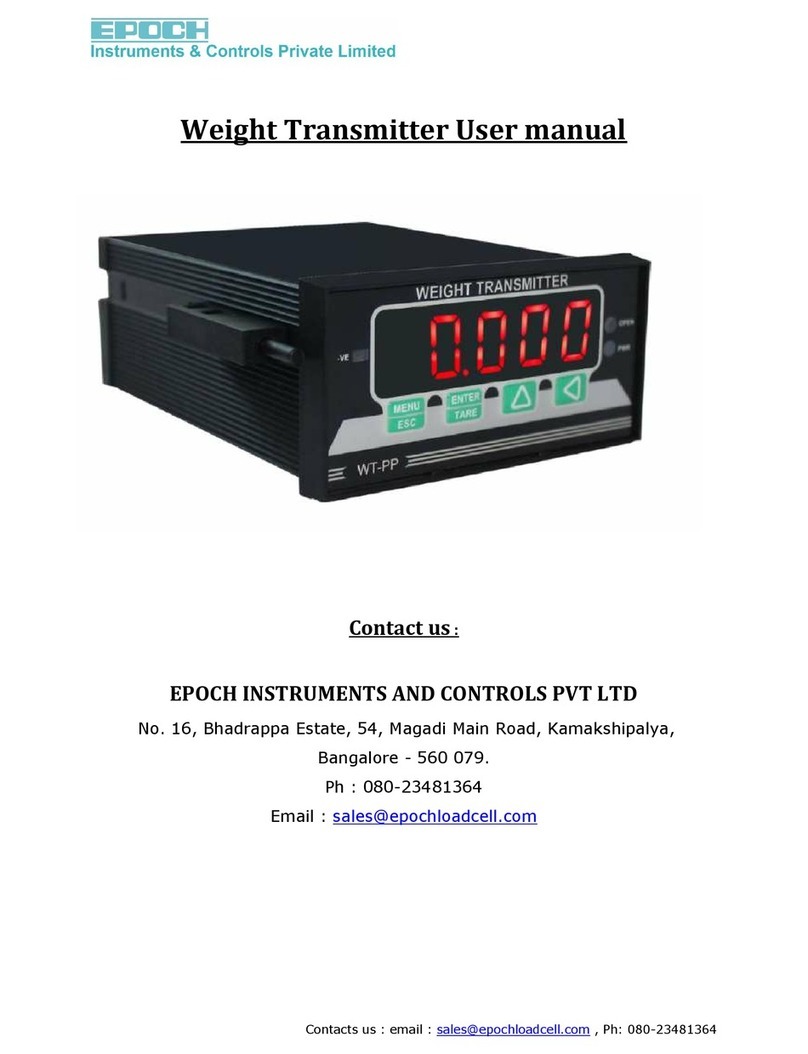
Epoch
Epoch WT-PP user manual
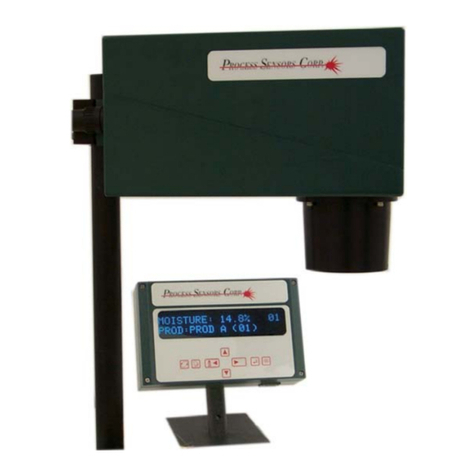
Process Sensors
Process Sensors MCT Series Installation and operation manual

Team Blacksheep
Team Blacksheep TBS UNIFY EVO manual
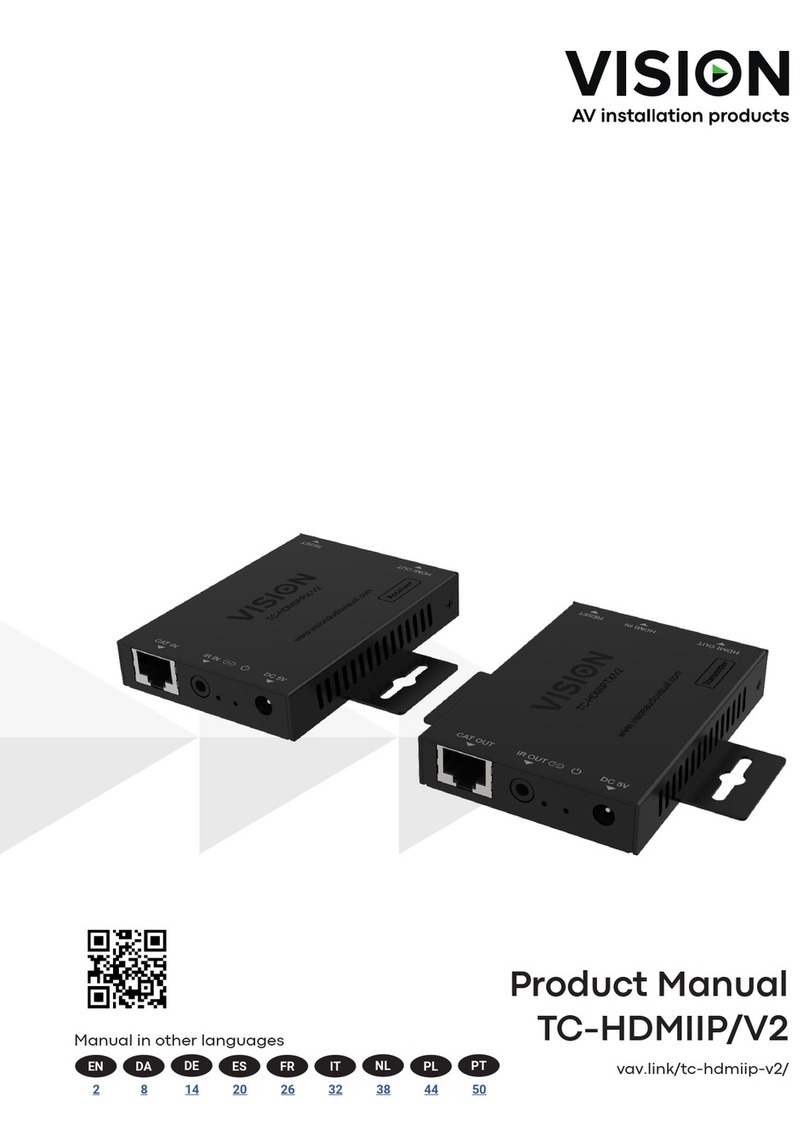
Vision
Vision TC-HDMIIP/V2 product manual
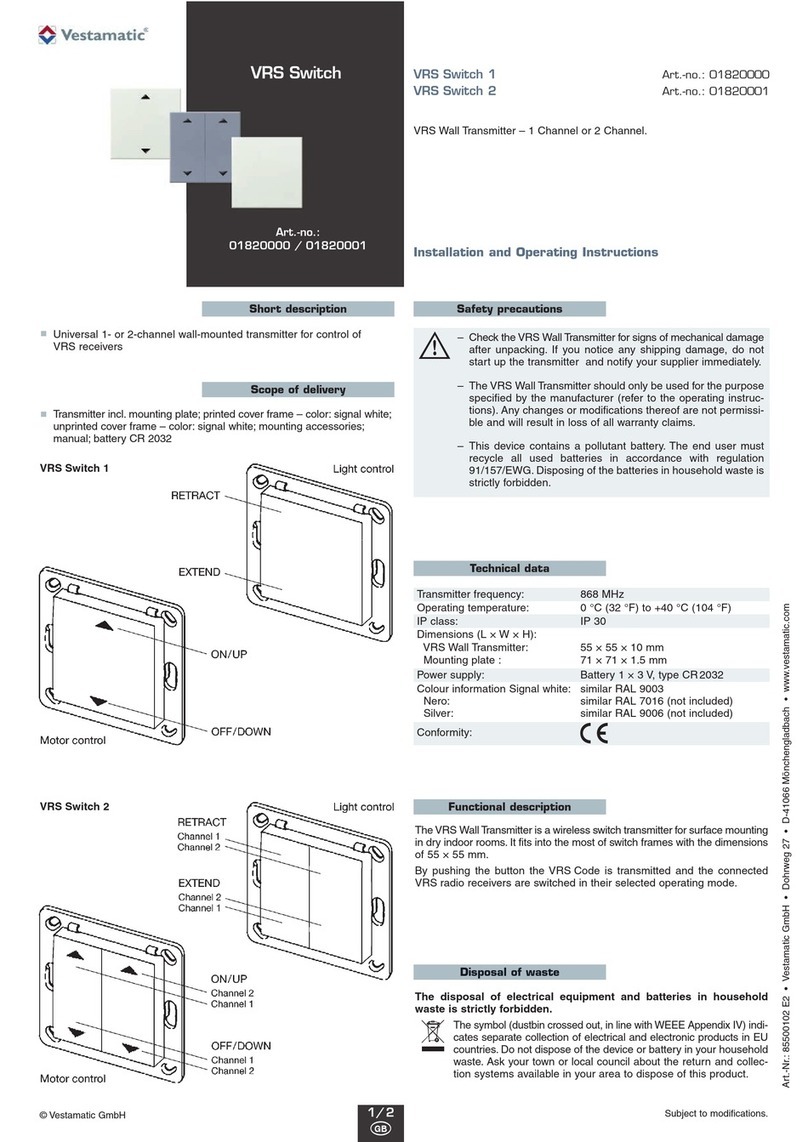
Vestamatic
Vestamatic VRS Switch 1 Installation and operating instructions
